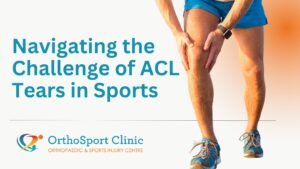
For athletes across all levels, an ACL (anterior cruciate ligament) tear is a formidable hurdle, not just for its immediate pain but for its potential to derail a sporting career. It’s an injury that can happen in the blink of an eye during a game or practice, and its impact is both physical and psychological.
What Happens During an ACL Tear?
The ACL is essential for knee stability, enabling athletes to perform dynamic actions like sudden stops, pivots, and jumps—common in sports such as soccer, basketball, and skiing. An ACL tear might occur during a non-contact maneuver—such as a rapid change in direction or landing awkwardly from a jump—or as a result of direct contact or collision.
Experiencing an ACL Tear
The moment an ACL tears is often dramatic: a sharp pain that might be accompanied by a loud “pop” sound. Swelling soon follows, alongside a decrease in range of motion and a troubling instability when putting weight on the leg. Diagnosing an ACL tear typically involves physical exams and an MRI, which reveals the extent of damage inside the knee.
Choosing the Right Treatment
The approach to treating an ACL tear varies:
Conservative Treatments: Not everyone opts for surgery. Some find that physical therapy focused on strengthening the knee can restore enough stability for daily activities.
Surgical Reconstruction: Athletes intending to return to high-level sports usually undergo surgery where the damaged ACL is replaced with a graft. This is followed by months of rigorous physical therapy.
Rehabilitation: Recovery is a slow and steady process, emphasizing regaining strength, flexibility, and confidence in the knee.
Preventing ACL Injuries
Prevention is better than cure, especially with ACL injuries:
Strength and Flexibility: Strong muscles support the knee. Exercises focusing on the hamstrings and quadriceps can protect the ligament.
Technique Training: Proper sports techniques can mitigate risky movements. Coaches play a crucial role in instilling these habits.
Adequate Warm-up and Cool-down: These routines prepare the muscles for the stress of sport and aid in recovery, reducing injury risks.
Appropriate Gear: The right shoes and, for some sports, knee braces can provide additional support and protection.
Recovery: A Multifaceted Journey
Recovering from an ACL injury is not just about physical healing but also about mental and emotional resilience. The road back to full activity can be long—typically six to twelve months—and filled with challenges. Support from a dedicated medical team, coaches, family, and friends is indispensable.
ACL injuries are a serious concern in the sports world, but with the right preventative measures and treatments, athletes can overcome these hurdles. Understanding the risks, staying diligent with training, and handling injuries with comprehensive care are key to not just recovery, but also to a long and healthy athletic career.
